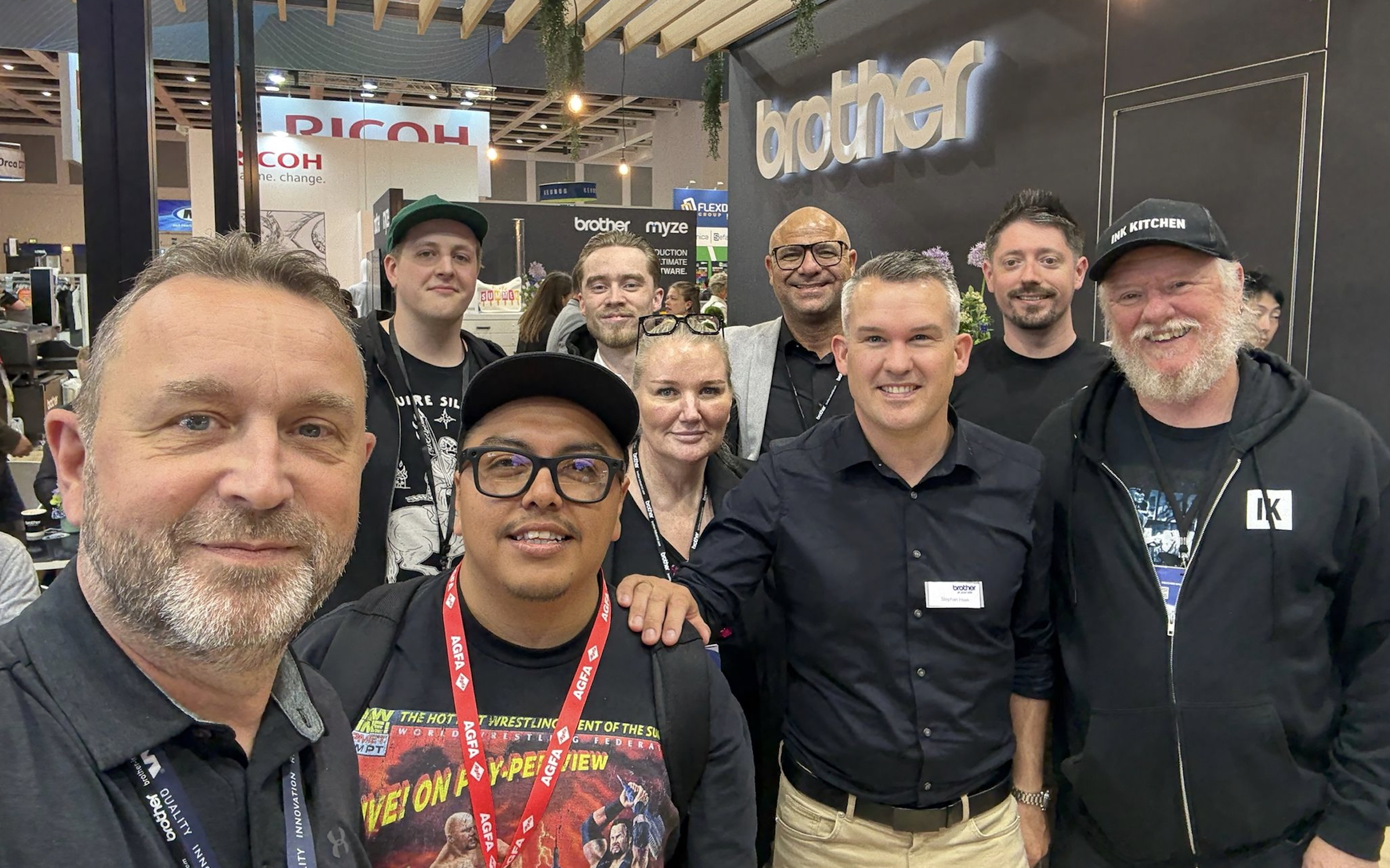There’s a lot more to the decorated-apparel industry than just what we see here in the United States
What follows are some observations gleaned from talking to printers and vendors from outside the United States while attending FESPA Global Print Expo, Europe’s leading decorated-apparel trade show, which took place this past spring in Berlin, Germany. The international perspective is an interesting one, as the European ways of doing business are a bit different from those in the States. It also didn’t take long to recognize the fact that the spirit of internationalism, outside the United States at least, remains alive and well.
Automation and the Decorated-Apparel Labor Force
Birth rates in the world’s most industrialized countries, particularly Taiwan, Japan, the United States and, most dramatically, South Korea, coupled with anti-immigration policies have created severe labor shortages. The United States alone is currently estimated to have almost a half million unfilled factory positions. The response in the marketplace is full speed ahead on automation.

Good help is hard to find these days in Europe as well as in the United States, putting a premium on automated systems, like this Kornit Apollo system. Photo by Eliot Neff
Where is this innovation happening? Everywhere. Custom-printing specialist Kornit, for example, was showing its Apollo system, in which a single unskilled operator can place a shirt into a machine that then takes it through a complicated series of steps after which it spits out a full-color printed garment. Production rates approach 400 shirts per hour. Not only that, but these 400 shirts can all be decorated with the same image or 400 separate images.
Other unskilled or low-skill positions being either eliminated or minimized in terms of the amount of labor involved include automated reclaim, laser screen imaging, folding and bagging, and a variety of other post-production and fulfillment tasks, like automated unloading, rotary automatic transfer applications and even squeegee cleaning. Every employee these days is precious. If an ink mixer makes printing go just a little bit faster, that is enough to make that purchase.
Financing Capital Expenditures and Decorated Apparel
How does one pay for all this automated equipment? We live in a world in which banks only seem to want to loan you five million dollars or more and will only do so if the loan can be secured with real estate. A credit card will only take you so far. Add to this the fact the days are over when if you bought an expensive piece of equipment you could expect it to hold its value and keep making you money for years on end. Technology is developing at such a dizzying pace these days today’s brilliant piece of equipment might very well be a boat anchor in a couple of years.
To deal with the combination of all this uncertainty and the current financing gap, another way of paying for equipment has come along—pay as you go, with some very expensive pieces of equipment now being paid for by the imprint by certain companies. This kind of financing is currently most frequently found in the larger digital machine space. But there is talk of it expanding to screen-printing and other equipment. It will be interesting to see how far it spreads. In a world where machine sales are not robust and buyers are increasingly apprehensive about the future, this is a creative way to get machines out of the warehouse and to customers.
China, Tariffs and the Future of Global Trade
So, is the Chinese economy going to be destroyed by tariffs created by the United States? The answer is a resounding, NO! And if it is going to happen, it will not be without a huge effort by China to counteract these tariffs. The European trade show was packed with Chinese companies displaying their wares. Bottom line: if they can’t sell to the United States they will simply sell elsewhere. In addition to all the Chinese booths, there were countless company representatives roaming the aisles making deals right and left.
Will there also be cheating to get around these tariffs? Absolutely! I have never in my life heard so many statements accompanied with winks, nods, knowing glances and unexplained assurances. I very much doubt the U.S. customs service is fully prepared to deal with the tide of goods having to comply with the dizzying array of ever-changing—taco anyone?—tariffs. My company recently had a simple inbound shipment delayed 20 days in customs, thereby missing our customer’s deadline. It will simply be impossible for an overworked customs agency to root out all the goods coming in under false documentation or identify those products that have entered via transshipments through countries with lower duty-rates.
In addition, we will undoubtedly see a rash of legitimate tariff dodging. Chinese companies, for example, may simply move their manufacturing to other countries, goods may be reclassified, and there will likely be massive exceptions.
Sustainability and Decorated Apparel Around the World
Despite current U.S. efforts to turn back the clock on environmental concerns, the rest of the world is continuing full speed ahead with recycled products, recyclable products, energy saving equipment, and other technologies and green endeavors designed to forestall global warming and cut down on pollution and waste in general.
In evidence at the trade exposition were many interesting efforts, including 1) the use of plastic grommets to allow for recycling of all-plastic banners, an important development given mixed-content items like a plastic banner with metal grommets or a poly/cotton shirt are some of the most difficult items to recycle 2) having your marketing be consistent with your products by giving out ballpoint pens with barrels made of wood rather than plastic and 3) a full range of recycled, recyclable and otherwise greener materials for all elements of the production process.
The Future of Custom Apparel Technology
As in the United States, the direct-to-film (DTF) industry continues to expand, with a wide range of machinery for all budgets, an equally wide variety of adhesives and inks, increased automation and increasingly creative forms of application. Ten years ago, who would have predicted the advent of carousel-style machines to apply transfers that much more rapidly?
That said, in response to those commentators saying direct-to-garment (DTG) is dead, perhaps we should drag out those same old prognosticators’ claims that DTG would kill screen printing. To my way of thinking, there will continue to exist, for a very long time, a range of different decoration techniques, each of which will have its place. The variety of audiences for decorated apparel is seemingly endless. Same thing with the variety of garments that continue coming to market, which in turn means the industry will continue to need a variety of ways to decorate all these new garments.
The Joy of Doing Business Abroad
One great lesson learned from interacting with businesspeople from around the world is that you can be serious about business, but you don’t have to do so in a joyless fashion. This was evident in everything from the relaxed rules at the show for food and drinks to the great beer and the long business dinners, where the point is to enjoy yourself and not just get served quickly.
The world is also a big place. This may sound trite, but that doesn’t make it any less true. The world may by based on dollars and the international language of business may be English, but that doesn’t mean a deal for many dollars can’t be negotiated in English between a business in Croatia and another business in Asia.
Free trade with no rules is like a hockey game without a referee—it can become ugly and unfair. You can’t have much of a game, though, playing all by yourself either. It was clear talking to folks from around the world that even if the United States decides to not play fair, everybody else is simply going to keep playing without them.
A stark reminder of the failure of international cooperation was seeing the Kaiser Wilhelm Memorial Church in Berlin, which instead of being rebuilt after being destroyed in 1943 was left in the ruins to serve as a kind of memorial to the victims of World War II. Let’s hope we can proceed internationally, and that it can be done fairly and in a way that benefits folks everywhere.
One of the true pioneers of today’s decorated apparel industry, Rick Roth is both the founder and CEO of Mirror Image Screenprinting & Embroidery (mirrorimage.com) and co-founder, along with his wife, Pam Ikegami, of The Ink Kitchen (inkkitchen.com), a free online clearinghouse for a wealth of information on the decorated apparel industry. He is also the host of “Shop Talk” at all three Impressions Expos and has long been active in the not-for-profit sector, helping out with causes ranging from Farm Aid to the needs of the homeless.
For some additional thoughts on the current global economic situation and the decorated apparel industry, click here.





